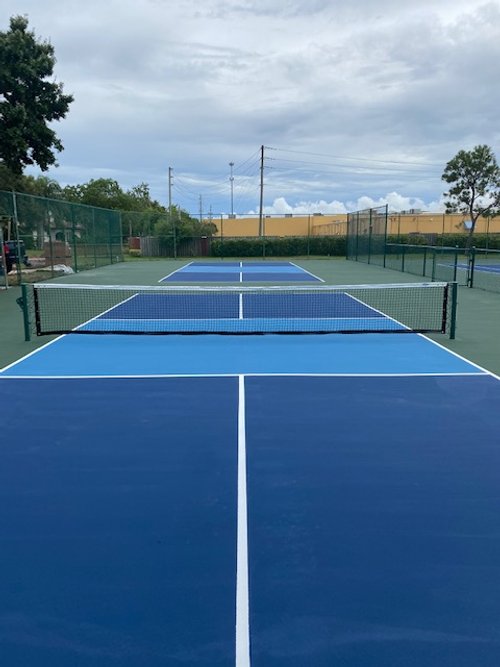Building a Pickleball Court Construction-- Specialist Construction for Quality Play
Building a Pickleball Court Construction-- Specialist Construction for Quality Play
Blog Article
Sustainable Practices in Pickleball Court Building You Ought To Know
As the appeal of pickleball remains to increase, so also does the need for sustainable techniques in court building and construction. This method not only addresses ecological issues yet additionally improves the longevity and capability of the courts. From choosing environment-friendly materials to applying efficient drain and energy-saving lighting options, there are numerous methods to think about. The impact of these methods prolongs much past the court itself. Recognizing how each component contributes to a much more lasting future invites additionally expedition into the complex equilibrium in between entertainment development and ecological stewardship.
Picking Eco-Friendly Products
Picking environmentally friendly materials is an important action in the construction of lasting pickleball courts. The option of lasting materials not only decreases ecological effect but also boosts the long life and efficiency of the court. Trick materials consist of reused rubber for the surface, which provides outstanding toughness and shock absorption while diverting waste from land fills.
Furthermore, utilizing in your area sourced materials minimizes transportation exhausts and supports local economic situations. Pickleball court construction. For instance, using indigenous woods for fencing and seats can offer a lasting aesthetic while ensuring strength against the aspects.
Integrating absorptive products for court foundations can additionally add to sustainability by enabling for all-natural water drainage and lowering drainage. These selections not only secure local communities but likewise advertise healthier play environments.
Efficient Drainage Solutions
While the option of eco-friendly products is important, executing efficient water drainage options is similarly crucial for preserving lasting pickleball courts. Appropriate drain not just protects the court surface area from water damage but additionally lessens erosion and runoff, advertising environmental honesty.
Efficient drainage systems can consist of permeable paving, which permits water to infiltrate the ground instead of merging externally. This decreases the possibility of standing water, which can bring about mold and mildew and other upkeep concerns. Additionally, integrating strategically positioned drainage channels and swales can route excess water away from the court area, making sure a completely dry playing surface and protecting against soil disintegration.
Using indigenous greenery in the landscape design around the courts can even more improve water drainage by absorbing excess water and decreasing runoff. These plants require less irrigation and promote biodiversity, aligning with sustainable techniques.
Moreover, it is vital to frequently preserve the drain system to guarantee its lasting efficiency. This includes cleaning particles and monitoring for clogs. By focusing on reliable drain services, pickleball court contractors can substantially contribute to the sustainability and longevity of the center, inevitably benefiting both players and the atmosphere.
Energy-Efficient Illumination Options
As the demand for pickleball remains to grow, incorporating energy-efficient lighting alternatives into court design has actually ended up being progressively important for sustainability. Typical illumination systems typically consume too much energy, adding to higher functional costs and ecological effect. Embracing modern-day, energy-efficient innovations is essential for both new buildings and improvements.
LED (Light Emitting Diode) lighting sticks out as a premier option because of its long life and power savings (Pickleball court construction). Compared to conventional lighting, LEDs use roughly 75% less power and can last as much as 25 times longer, considerably decreasing maintenance expenses. The directional nature of LED illumination lessens light pollution, ensuring that illumination is concentrated on the court rather than bordering areas.

Lasting Surface Area Alternatives
Exploring sustainable surface area alternatives for pickleball courts has gotten grip among players and builders alike. The emphasis on environment-friendly products not just aligns with the growing environmental understanding yet additionally boosts the efficiency and resilience of the courts.
This product offers excellent shock absorption, lowering the danger of injuries for gamers while promoting sustainability. These floor tiles are simple to mount and replace, and their convenience allows for different court configurations.
Natural lawn courts are additionally becoming a sustainable selection, advertising biodiversity and decreasing the warm island effect. Nevertheless, they call for normal maintenance and water, which may not straighten with all sustainability goals.

Water Conservation Strategies

An additional efficient technique includes the installment of rain harvesting systems. These systems accumulate and store rainwater for usage in maintaining court surfaces and landscape design. This strategy not only saves potable water but likewise lowers reliance on local resources.
Moreover, employing drought-resistant landscaping around the courts is crucial. Native plants need less water and are better adjusted to neighborhood environment problems, hence decreasing overall water usage. Furthermore, making use of reliable watering systems, such as drip irrigation, guarantees that water is provided directly to plant roots, lessening evaporation and waste.
Final Thought
Incorporating sustainable techniques in pickleball court building and construction dramatically contributes to ecological conservation and resource effectiveness. By focusing on these practices, the building of pickleball courts can straighten with more comprehensive ecological goals while advertising longevity and performance within areas.
As the popularity of pickleball continues to increase, so also does the need for sustainable practices in court building.Selecting green products is a vital step in the building of try these out sustainable pickleball courts. By prioritizing energy-efficient lighting alternatives, pickleball court erectors can add to a much more sustainable future while meeting the needs of stakeholders and gamers alike.Integrating sustainable surface choices not just enhances the performance of pickleball courts yet likewise paves the way for implementing reliable water conservation methods.Incorporating lasting methods find more in pickleball court construction considerably adds to environmental conservation and resource performance.
Report this page